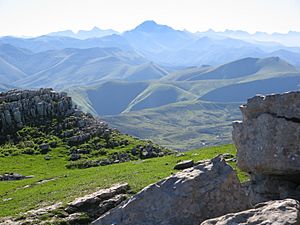Battle of Roncevaux Pass (824) facts for kids
Quick facts for kids 2nd Battle of Roncevaux Pass |
|||||
|---|---|---|---|---|---|
| Part of Louis the Pious' attempt to control the Marca Hispanica and Vasconia | |||||
|
|||||
| Belligerents | |||||
| Franks (Carolingians), Basques (Gascons) | Basques (Navarrese, Aragonese), Qasawi Muslims | ||||
| Commanders and leaders | |||||
| Count Aeblus, Duke (Count) Aznar Sánchez | Unknown (speculated: Enneko Aritza and Musa II Al-Qasawi) |
||||
| Strength | |||||
| Unknown | Unknown (guerrilla party) | ||||
| Casualties and losses | |||||
| Carolingian expedition crushed, commanders captured | Unknown | ||||
The Battle of Roncevaux Pass was an important battle in 824. In this fight, a combined army of Basques and Qasawi Muslims defeated a military group from the Carolingian Empire. This battle happened near the Roncevaux Pass in the Pyrenees mountains. It was only 46 years after another famous battle in the same place in 778. Both battles involved Basque fighters from the mountains attacking Frankish armies.
This battle had a big impact. The Carolingian army was defeated, and their leaders, Aeblus and Aznar Sánchez, were captured. This victory led to the quick creation of the independent Kingdom of Pamplona.
Why the Battle Happened
After a military trip by Louis the Pious around 814, a Basque leader named Enneko Aritza became very powerful in Pamplona. He had strong family ties with the Banu Qasi family, led by his half-brother Musa. Around 816, after news of Charlemagne's death spread, a Frankish leader in Pamplona was defeated.
In 816, the rebellion in Pamplona spread north across the Pyrenees mountains. Louis the Pious removed Seguin, the Duke of Vasconia, for not stopping the rebellion. This caused an even bigger revolt. Basque lords on both sides of the Pyrenees rebelled. They were later defeated in Dax by Louis in 817. Another duke, Lupus Centullo, was appointed but also rebelled and was removed. In Aragon, a pro-Frankish count was overthrown by Enneko's ally. At this time, the Frankish control over the Hispanic Marches was becoming very weak.
The Battle Itself
In 824, the Carolingian king gathered an army from the part of Vasconia still under Frankish rule. This army was led by Duke Aznar Sanchez, who commanded Basque troops from Gascony, and Count Aeblus, who led a Frankish army. Their goal was to crush the Basque rebellion centered in Pamplona.
The army reached Pamplona without any fighting. After taking goods from the town, they started their journey back north. However, Umayyad historians say that a combined force of Navarrese (led by Enneko Aritza), Aragonese, and Banu Qasi warriors were waiting. They hid in the forests along the narrow, winding paths of the Cize region.
The Basques attacked the Carolingian army in their own territory. The Carolingian forces were completely defeated. Both commanders of the expedition, Aeblus and Aznar Sanchez, were captured.
What Happened Next

After the battle, the Frankish count Aeblus was sent as a prisoner to Córdoba. However, Aznar Sánchez was set free because he was related to his captors. This showed that the Banu Qasi and Arista families had good relations with the Umayyad rulers in Córdoba at that time.
Enneko Aritza was the clear winner of the battle. He became the undisputed ruler of Pamplona. This new, independent Basque kingdom meant that the lands south of the Pyrenees were now completely separate from the Duchy of Vasconia, which was under Frankish control. The Franks also lost control over the Hispanic Marches. The battle also marked the beginning of an on-again, off-again alliance between the kings of Pamplona and the Banu Qasi family.
See also
 In Spanish: Segunda batalla de Roncesvalles para niños
In Spanish: Segunda batalla de Roncesvalles para niños


